View the entries from the 2020 Anyone Can Win contest.
The Winners!
 1st Place Over 18:
1st Place Over 18: Shirley Shaw
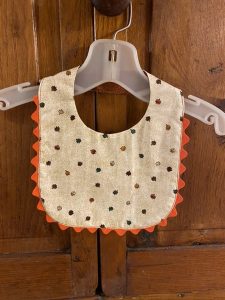 2nd Place Over 18:
2nd Place Over 18: Carol Coleman
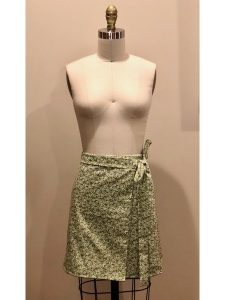 1st Place Under 18:
1st Place Under 18: Brooke Neuberger
 2nd Place Under 18:
2nd Place Under 18: Regan Ray
View the entries from the 2020 Anyone Can Win contest.
 1st Place Over 18:
1st Place Over 18:  2nd Place Over 18:
2nd Place Over 18:  1st Place Under 18:
1st Place Under 18:  2nd Place Under 18:
2nd Place Under 18:
In this article, we review a catch-all “Other” category of basic sewing tools that includes thread snips, seam rippers, point turners and stilettos:
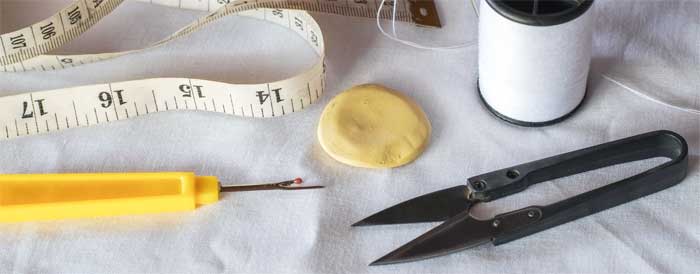
Thread snips, also called thread nippers, thread clippers, and thread cutters—are small, often spring-loaded, scissors used for trimming threads and are easy to keep close to your sewing machine for quick access to trim at the end of each seam. Some varieties are more heavy duty and can even be used for notching fabric.
Thread snips come in various designs, sharpness, and price points.
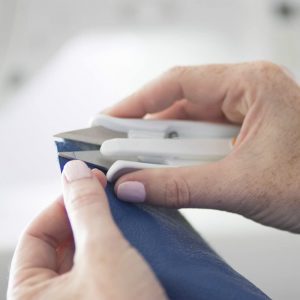
Seam rippers are a small tool used for removing stitches. There are two primary styles:
No matter which style you choose, it is always important to use care not to slice your fabric as you pick out your stitches.
Point turners are usually made from either plastic or bamboo. They are a great tool for creating sharp corners and can also be used to crease or mark fabric temporarily. Be careful not to poke the pointed end through your fabric as you turn out your corners. Simply insert the pointed end inside the corner and pull the fabric over the end. If you have trimmed your seams well, you should have a beautiful sharp point.
Here’s a 1-minute video tutorial that will give you some quick tips on how to use your point turner. You may be surprised about some extra functions you can get out of this handy little tool!
Stilettos, sometimes called awls, are a great help at the sewing machine to help move fabric under the presser foot as well as several other functions. They come in a variety of styles and materials such as metal, bone, and wood. Regardless of style, they will have at least one, and sometimes two, pointed ends and a handle to hold onto. The sharp point can ride along close to your presser foot and act like a safe extra finger to help you hold fabric in place while sewing. They can be useful when picking out stitches or turning under small edges of fabric. They can also hep you to safely secure your fabric while pressing without getting too close to a dangerously hot iron.
Many stiletto options are available in sewing shops but for the non-traditionalist, you can improvise with things like a bamboo skewer (think shish-kabobs), a porcupine quill or even an ice pick.
We hope you found something new or were reminded of something old as you read through this list of sewing tools. And if you decide to try a new tool or replace an old one, don’t forget to take advantage of your member discount as you do.
See our full series of Sewing Basics/Learn to Sew articles.
~Sheryl Belson
In this video, Sheryl Belson interviewed Anita Morris from Anita by Design. You will love Anita’s exuberance, authenticity, joy and sparkling smile! She shares her passion for helping people learn to sew, her unique way of planning her sewing projects, as well as how she has weathered some of life’s hardest moments. This chat is one you definitely don’t want to miss. You can follow Anita on Instagram and YouTube.
~Sheryl Belson
Q. Independent Pattern Designer
A. Itch-to-Stitch
Q. Name and Number of Pattern
A. Bonn Shirt/Dress
Q. Fabric Used:
A. Picasso Rayon Poplin in teal
Q. Special Embellishments/Notions Used
A. Superior MasterPiece cotton thread
Q. Skill level required?
A. Advanced beginner or Intermediate
Q. Are the instructions easy to follow?
A. Yes, and they are quite thorough. There are several sleeve variations of long, short, mid-length and flare; this is the long flare. I’ve made the mid-length also, in a blue rayon print. Have not made the dress.
Q. Are you pleased with the finished result? Did it meet your expectations?
A. Very pleased. I had a bit of difficulty with the hem this time. I chose to use a rolled hem foot to make it simpler than trying to press 1/8″ double ironed hem with slippery rayon. The result is that the hem has a fluttery look, which mimics the flared sleeve.
Q. Did it look like the picture?
A. Yes, it did.
Q. Did you make any modifications in the pattern?
A. No.
Q. Are there any changes you would have made?
A. I might try it with a straight hem, rather than a curved one, and perhaps add a side slit. If I did that, I would also do the mid-length sleeve and make that hemmed rather than gathered and banded.
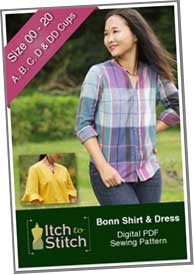 Q. Did the pattern teach you any unique or special techniques?
Q. Did the pattern teach you any unique or special techniques?
A. This was the first flared sleeve I’ve sewn. I like the effect.
Q. Would you make this again?
A. Yes.
Q. Would you recommend this pattern to others?
A. Yes, I would.
Pattern Link: https://itch-to-stitch.com/pattern-release-bonn-shirt-dress/
I purchased the fabric from a store in Missoula, Montana that also has a web site, The Confident Stitch. The online store and their customer service customer are top notch.
~Joanne Jensen, Plano Chapter
Not really designed for construction, variegated threads are multiple colors within a single strand. When you look at a spool, you may see distinct color patterns or simply a blending of similar colors, depending on the brand, how the thread is dyed and how it’s wound on the spool or cone. Stitching with these threads on your sewing machine also produces differing results. Sometimes, surprises happen unexpectedly!
The spacing and repetition of colors within the spool vary by thread type and brand. Some multi-color threads repeat colors in a regular sequence, others offer random color repeats and others may change hue every inch, or every few feet. Colors can be related by shade, such as a light, medium and dark tone of the same color, or they can be bold contrasting colors, like a mix of red, white and blue within the same strand.
Sometimes the color change is distinct, abruptly changing from one to the another, but more often the changes are gradual with a melding from one shade to the next.
How the thread is dyed determines how it stitches out, in combination with other factors like stitch length and width, and the actual stitch selection.
Look for variegated threads in multiple fiber options—cotton, polyester, rayon, metallic, silk and texturized nylon. They also come in different thread sizes, depending on the use. Heavier weights are ideal for multi-color free-motion quilting.
Variegated threads can be used in a number of ways. Satin stitching takes on an entirely new persona creating stripes of color—either distinct or melding.
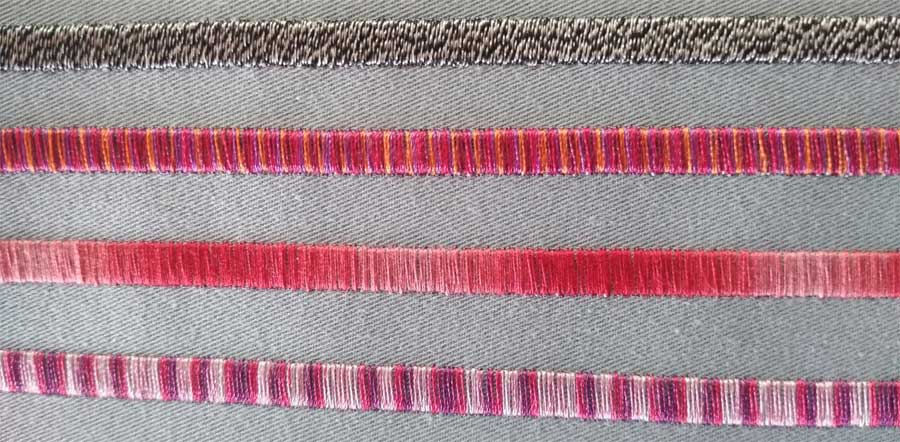
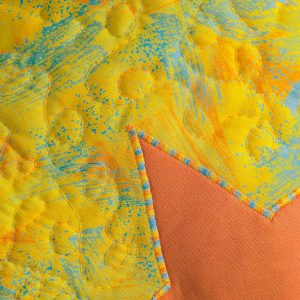
A striped appliqué edge is interesting as well. Topstitching with variegated thread is fun, free-motion quilting allows for blending colors found in fabric prints, and the world is your oyster with decorative machine stitches.
When selecting decorative stitches, look for those that are formed only with a forward motion for the best color clarity. If you choose reverse-motion stitches, you can end up with slightly different colors on top of each other as the stitch is formed.
Variegated thread also makes interesting serging stitching lines, whether used as an edge finish or for flatlocking within a garment. Unless both sides show, use the variegated thread only in the upper looper and needle, along with a coordinating solid in the lower looper.
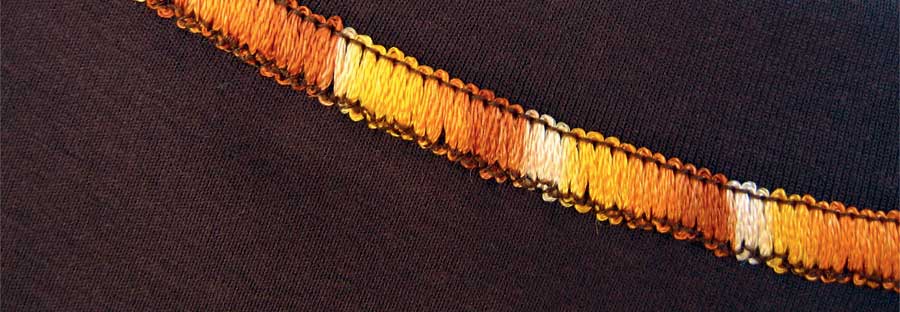
Machine embroidery is a great place to use variegated threads for either subtle or bold shade changes. But, be aware that depending on the thread patterning, you can end up with stripes in your programmed design.
Before committing to a project, be sure to test-stitch with the variegated thread and stitch settings you plan to use to see how the color variations will actually stitch out. Or, better yet, try the same design with different variegated thread types and brands.
Another type of multi-color thread is twisted thread—two or three plies of different colors twisted together to create a heathery look. Look for analogous color shades (like light blue and dark blue) creating a denim look, or more contrast in colors for bolder effect.
Twist threads are ideal for embroidering animal motifs with fur or feathers, topstitching and decorative stitching where you don’t want stripes to be prominent.
There are several types of hand-stitching threads available with multi-coloration. Look for embroidery floss and fine wools, as well as multiple sizes of variegated pearl cottons.
So, add some color changing to your world!
~Linda Griepentrog
Linda is the owner of G Wiz Creative Services and she does writing, editing and designing for companies in the sewing, crafting and quilting industries. In addition, she escorts fabric shopping tours to Hong Kong. She lives at the Oregon Coast with her husband Keith, and two dogs, Yohnuh and Abby. Contact her at .
American Sewing Guild
National Headquarters
9660 Hillcroft, Suite 230
Houston TX 77096
713-729-3000 | 713-721-9230 Fax
www.ASG.org
